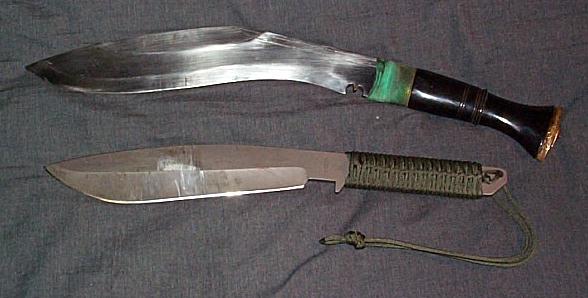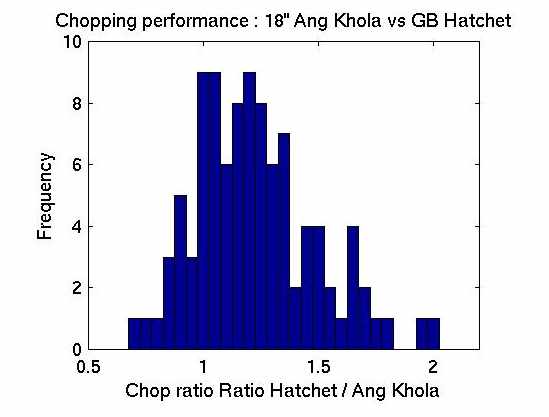
A shot of the 18" Ang Khola from Himalayan Imports alongside a PAB :

This khukuri came about as a request from Dennis Saccher who wanted something in between the fifteen and twenty inch Ang Khola's. The eighteen inch model ( total length) weighs 920 grams and is balanced 3.8" infront of the grip. The forged spring steel blade has a deep fuller and convex edge. The edge starts off with a 10 degree sweep to the shoulder and increases gradually to a 16 degree angle in the apex of the edge. The scabbard is neat, tight and fits the blade well though it cannot hold the khukuri upside down if shook.
The 18" Ang Khola isn't what comes to mind when thinking of a kitchen knife however it does have a few properties which lend itself to such use. The angled blade actually allows efficient work to a cutting board and the curved edge allows for efficient slicing. Primarily to cut many foods well the edge must be very sharp and once the khukuri has been properly honed it will slice many foods well. It easily slices up some pork :

makes fine cuts through green onions :

and dices celery :

The khukuri also easily cuts up tomatos :

slices up some blood pudding :

and some banana bread :

The blade is of course fairly heavy in hand, in fact more effort is spent lifting the blade than actually pressing it through the foods. It isn't a blade which would be picked to cater a wedding but the fatigue isn't so high that it would prevent cooking a meal. The only real issues are on stiff vegetables as it will tend to fracture carrots :

and slicing thick turnips are problematic as it takes a lot of force to drive the thick blade through the slices.
On light brush, the Ang Khola readily outperforms the Wildlife hatchet which tends to hang under the bit. The khukuri readily cuts grasses which is just a matter of sharpness and has enough length to cut a large swath readily however the large amount of chopping power isn't of significant benefit and thus the fatigue rate tends to be high :

As the vegetation gets thicker then the heft of the khukuri starts to have some benefit but even on stalky weeds a significant fraction of an inch thick the blade is barely slowed. This means that there is more fighting against the power than using it :

Generally such work is more efficient with a lighter knife such as the Battle Mistress. A light machete such as made by Tramontina works very well as does a slim Leuko which has similar handling butlacks the reach of the machete.
On springy woods such as alders the performance of the Ang Khola moves closer to the lighter blades but is still less than most desirable because the wood still doesn't have the necessary rigidity to enable the large amount of power of the khukuri to be transferred to the cut, the wood just tends to move with the blade which wastes a lot of the power of the swing. However the optimal blade is no longer a thin machete because some rigidity and more heft is needed to cut such wood well compared to grasses. A blade with more heft like the Barteaux machete works very well as does the Tramontina Bolo and Valiant Golok . The Battle Mistress cuts and handles well, but suffers from lack of reach compared to the longer blades.
For limbing, the khukuri does very well. The edge is acute enough to slice off small limbs on saplings and there is easily enough power to chop off the thicker limbs. The closest competion to the khukuri for limbing is the Valiant Golok which compensates for less power on the swing by having more speed. The Ratweiler and similar blades work well but lack the raw chopping ability of the Ang Khola and the reach. The khukuri will pull ahead strongly over such blades once the limbs start to get over an inch or so thick on harder woods like spruce as the Ang Khola will still clear them off in one cut.
As a heavy chopper on fresh woods the khukuri excells on birch, pine, spruce and juniper. It compared well to the Wildlife hatchet in terms of penetration and fluidity. Both were used to cut just under a hundred rounds bucked to length from three to seven inches thick. The ratio of number of chops (hatchet vs khukuri) was 1.20 (3). In detail :

Though the average performance is quite stable there is a lot of variation in wood from one piece to the next even from the same tree. Often it is immediate that there is a difference but to obtain a decent performance estimate takes a fair amount of wood. Note this ratio only held for wood which is opened up by one notch, on larger wood the hatchet will pull ahead due to its ability to get the same penetration irregardless of the size of the wood.
Moving to seasoned lumber, the khukuri also does well, but in general it is more suited to fresh woods. Dried lumber also tends to fracture readily under the massive impacts of the khukuri.
As a splitter, it works much better for chop splitting than blades like the Battle Mistress but is generally behind the Wildlife hatchet. It easily takes a decent round and readily chop splits slabs from the sides until the round can be reduced in size and split directly. The method is the same as with an axe; a powerful chop to start and then invert the blade and bring the spine down sharply using the weight of the round to drive the blade into the wood :

Wedges can also be made from the slabs quickly which allows direct splitting of much larger woods. The khukuri also works well for the fine splitting necessary to separate the wood into finer pieces for tinder :

For general utility, the khukuri is very strong in both the tip and main body and thus works well for prying. It easily helps in breaking down an old step for a renovation project and breaks apart a stump for pitch wood. It also easily works as a hammer driving stakes and smashing concrete blocks with ease. On harder work such as cutting sod, the edge indented more readily than a village khukuri which showed a lower hardness for the Ang Khola.
The Ang Khola was also compared to various other production blades including khukuris from other manufacturers and in general did very well.
When chopping, the large khukuri isn't used the same as a blade like the Battle Mistress which is much lighter and more neutral in balance. Since the khukuri has a far greater moment of inertia, which just means it takes more force to rotate, the muscles of the shoulder, back and hips need to be used. Knives like the Battle Mistress can be swung mainly from the elbow at maximum speed and with still lighter knives like the Ratweiler the wrist is the main source of power. With proper technique the swing times for all of those blades are similar for heavy chopping and personally approach about two hits per second at maximum, though in general the working pace is less than half of that. Of course personal strength has a great influence, if the wrists and forearm were exceptionally strong then even the heavy khukuris could be used for extended periods of time with little shoulder strain.
The Ang Khola is forged spring steel and has little corrosion resistance. Specifically for example at times it was used outside in the rain. During period of inactivity of 10-15 minutes while cut wood was piled or used in construction of shelters, visible rust would form on the blade. The same was seen with the Wildlife hatchet which is made out of a similar steel. Visible corrosion will be seen almost immediately after cutting through onions, tomatoes and similar acidic foods :

The Ang Khola is capable of extended wood working before it loses the ability for precision cutting such as cutting light grasses. Unless the edge is damaged by hitting a rock covered by brush multiple sessions of several hours each of limbing and felling are performed before the khukuri needs to be resharpened. The performance is significantly ahead of blades like the Tramontina bolo which was much softer and thus the edge would roll/deform easier.
The Ang Khola has a complicated grind which has a convex edge bevel and a hollow primary grind similar to a hardwood axe. The most efficient method to sharpen the edge found to date is a modified version of the method that Jimmy Fikes demonstrated in his blade testing video. Usually it is only necessary to work the edge on a 800 grit waterstone for a few minutes and then finish on a 4000 or similar waterstone and then some light passes on 0.5 micron chromium/aluminum oxide loaded leather. The entire process only takes a few minutes. If the edge has some visible damage then a few minutes are first taken with a 200 grit silicon carbide waterstone. The edge can be honed on various jigs and v-rods however this will induce the edge to thicken fairly rapidly so periodically the entire edge should be worked with an x-coarse stone to keep the secondary bevel minimized.
The khukuri handle is often an issue of much concern, especially the median ridge, but this is actually an integral part of the central martial grip. The handle works well in hammer and sabre grips. The actual blade actually works as a secondary grip when the blade is used for precision work, the deep fuller enhances grip retention.
The 18" Ang Khola has enough length to make it efficient for brush work however it has more power on the swing than necessary and thus a lighter blade tends to be more efficient for lighter user. The khukuri works very well for felling and limbing of small to medium sized woods and has high general versatility due to the extreme strength and overall durability. The corrosion resistance is fairly low as it is a spring steel and it also has low wear resistance so isn't a good choice for extended cutting on abrasive media. For wood working it stays sharp for an extended period of time, much longer than traditional machetes and it is readily sharpened with natural waterstones.
Comments can be sent to : cliffstamp[REMOVE]@cutleryscience.com and posted to :
For additional information there is also Himalayan Imports website. PhotoBucket Album.
| Last updated : | 01 : 10 : 2006 |
| Originally written: | 01 : 28 : 2000 |